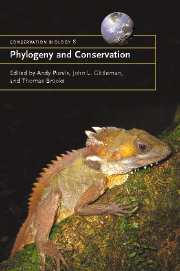Book contents
- Frontmatter
- Contents
- List of contributors
- 1 Phylogeny and conservation
- Part 1 Units and currencies
- Part 2 Inferring evolutionary processes
- Part 3 Effects of human processes
- 12 Conservation status and geographic distribution of avian evolutionary history
- 13 Correlates of extinction risk: phylogeny, biology, threat and scale
- 14 Mechanisms of extinction in birds: phylogeny, ecology and threats
- 15 Primate diversity patterns and their conservation in Amazonia
- 16 Predicting which species will become invasive: what's taxonomy got to do with it?
- Part 4 Prognosis
- Index
- References
12 - Conservation status and geographic distribution of avian evolutionary history
Published online by Cambridge University Press: 04 December 2009
- Frontmatter
- Contents
- List of contributors
- 1 Phylogeny and conservation
- Part 1 Units and currencies
- Part 2 Inferring evolutionary processes
- Part 3 Effects of human processes
- 12 Conservation status and geographic distribution of avian evolutionary history
- 13 Correlates of extinction risk: phylogeny, biology, threat and scale
- 14 Mechanisms of extinction in birds: phylogeny, ecology and threats
- 15 Primate diversity patterns and their conservation in Amazonia
- 16 Predicting which species will become invasive: what's taxonomy got to do with it?
- Part 4 Prognosis
- Index
- References
Summary
INTRODUCTION
Phylogeny affects conservation at multiple levels. At the level of the vision of conservation – of the long-term persistence of the processes that maintain biodiversity – phylogeny informs how we should represent these evolutionary processes (see, for example, Chapter 11). At the level of the goal of conservation – of representing the planet's biodiversity in a comprehensive conservation system – phylogeny reveals the units requiring representation (see, for example, Chapter 2). Finally, at the level of conservation strategies, phylogeny gives an extra dimension of biodiversity value that can be incorporated into conservation prioritisation (see, for example, Chapter 5). Here, we explore this third level.
Efficient biodiversity conservation requires systematic prioritisation of efforts; ad hoc planning has significant economic and societal costs (Pressey 1994). In a major review of systematic conservation planning, Margules & Pressey (2000) conceptualised the framework for conservation strategy as requiring two variables: ‘irreplaceability’ and ‘vulnerability’. Irreplaceability refers to uniqueness, or the extent to which a given biodiversity feature will be needed to contribute to a set of conservation values; vulnerability refers to threat, or probability of loss of biodiversity value (Pressey & Taffs 2001). This framework was originally conceived as operating across geographic space (i.e. applied to the prioritisation of sites, whether specific protected sites or broad biogeographic regions). Here, we extend the concept to application across phylogenetic space: prioritisation between species. Throughout this chapter, ‘irreplaceability’ and ‘uniqueness’ are used interchangeably, as are ‘vulnerability’ and ‘threat’.
- Type
- Chapter
- Information
- Phylogeny and Conservation , pp. 267 - 294Publisher: Cambridge University PressPrint publication year: 2005
References
- 4
- Cited by



